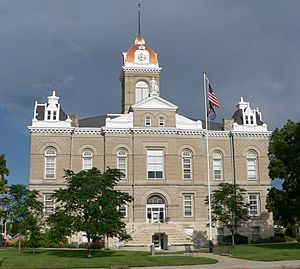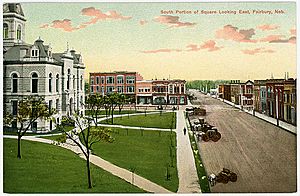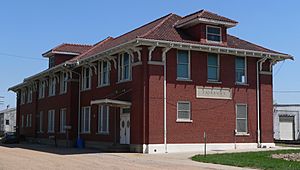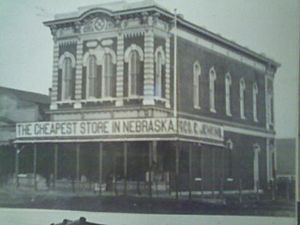Fairbury, Nebraska facts for kids
Quick facts for kids
Fairbury, Nebraska
|
|
|---|---|
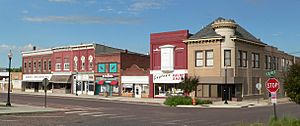
Downtown: west side of D Street
|
|

Location of Fairbury, Nebraska
|
|
| Country | United States |
| State | Nebraska |
| County | Jefferson |
| Area | |
| • Total | 2.54 sq mi (6.58 km2) |
| • Land | 2.54 sq mi (6.57 km2) |
| • Water | 0.00 sq mi (0.01 km2) |
| Elevation | 1,414 ft (431 m) |
| Population
(2020)
|
|
| • Total | 3,970 |
| • Density | 1,565.46/sq mi (604.48/km2) |
| Time zone | UTC-6 (Central (CST)) |
| • Summer (DST) | UTC-5 (CDT) |
| ZIP code |
68352
|
| Area code(s) | 402 |
| FIPS code | 31-16410 |
| GNIS feature ID | 2394728 |
| Website | fairburyne.org |
Fairbury is a city in Nebraska, United States. It is the main city and county seat of Jefferson County, Nebraska. In 2020, about 3,970 people lived there.
Fairbury has a long and important connection with railroads. The city was started because a railway was planned to go through it. It grew into a busy shipping center. For almost 80 years, Fairbury was the main office for the Western Division of the Rock Island Railroad. The city did very well when the railroad was strong. But as the railroad became less active, Fairbury also saw fewer businesses and residents.
Contents
History of Fairbury
How Fairbury Began
In 1868, a man named James B. Mattingly started a sawmill near the Little Blue River. Soon after, Woodford G. McDowell, a businessman from Fairbury, Illinois, came to Nebraska. He wanted to plan a new town along the route of a new railroad. In 1869, Mattingly and McDowell each gave 80 acres of land. They named the new town Fairbury, after McDowell's hometown in Illinois.
The new town grew quickly, even before the railroad arrived. In 1870, about 370 people lived there. A newspaper, the Fairbury Gazette, also started that year. In 1871, Fairbury was chosen as the county seat, which means it became the main city for the county's government. The city officially became a city in early 1872. By then, it had three hotels and five blacksmith shops.
Railroads and Growth
In 1872, the St. Joseph and Denver City Railroad reached Jefferson County. This railroad was later taken over by Union Pacific. Fairbury became a key place for shipping goods. In just the first half of 1873, the city shipped 255 train cars of grain and received 143 cars of lumber. By 1874, Fairbury had 600 residents and 44 businesses.
In 1879, a large fire destroyed about fourteen buildings, causing a lot of damage. But the city recovered quickly. Many of the wooden buildings were replaced with stronger brick and stone ones. By 1882, the city's population had grown to 1,600 people.
From 1885 until 1913, the Campbell Brothers Circus spent its winters in Fairbury. At its busiest, this circus was the second-largest in the world!
In 1886, the Chicago, Rock Island and Pacific Railroad arrived in Fairbury. The city was a meeting point for the Rock Island's north-south and east-west lines. Because of this, Fairbury became the main office for the railroad's Western Division. A huge rail yard was built, with shops, storage areas, and a large roundhouse. The railroad had a big effect on Fairbury. By 1890, the population had grown to 2,630.
The old brick courthouse was too small for the county's growing needs. In 1889, people voted to build a new courthouse. The new Romanesque Revival building was finished in 1892.
Fairbury continued to do well as the home of the Rock Island headquarters. Many local people worked for the railroad or in businesses that supported it. New shops and homes were built. The city also improved its streets with brick sidewalks and got electricity and street lights by 1898. By 1900, the population reached 3,140.
Fairbury in the 20th Century
The years from 1900 to 1910 saw the biggest growth in Fairbury's history. The population jumped by 60%, reaching 5,294 people in 1910.
Another big fire in 1903 destroyed most of the shops south of the courthouse square. Only the original brick courthouse survived. But within a year, the entire area was rebuilt.
In 1909, E. J. Hested opened his "dime store" called The Fair Store. Two years later, it became Hested's. This store grew to have over 150 locations across the Midwest before it was sold in 1969.
The 1910s and 1920s were the best years for the Rock Island Railroad. Fourteen passenger trains passed through Fairbury every day, and hundreds of Fairbury residents worked for the railroad. A new train station was built for $40,000. The city's shopping area also grew, adding two movie theaters and many large stores. By 1930, Fairbury had 10 miles of paved roads. Many new businesses for cars, like garages and gas stations, also opened.
Fairbury managed the Great Depression better than many other towns. Besides the railroad, it had different industries, like the Fairbury Windmill Company, which employed 50 people in 1930. The city continued to grow during the Depression. The population of Fairbury reached its highest point in 1950, with 6,395 residents.
After 1952, the Rock Island Railroad started using diesel locomotives instead of steam engines. This made parts of the Fairbury rail yards no longer needed. Fewer people traveled by train after World War II, so train services were reduced, stations closed, and tracks were removed. In 1965, the famous Rocky Mountain Rocket train stopped running through Fairbury. In the same year, the railroad moved its Western Division headquarters from Fairbury to Des Moines, Iowa. The Rock Island Railroad faced more problems and finally stopped service to Fairbury in 1980. The train station was then left empty.
Geography and Climate
Fairbury's Location
Fairbury is located on the Little Blue River. The city covers about 2.40 square miles (6.22 square kilometers) of land.
Weather in Fairbury
Fairbury has a climate with warm summers and cold winters. The hottest month is July, with average highs around 88 degrees Fahrenheit (31 degrees Celsius). The coldest month is January, with average lows around 14 degrees Fahrenheit (-10 degrees Celsius). The city gets about 32 inches (82 centimeters) of rain each year.
| Climate data for Fairbury, Nebraska (1991–2020 normals, extremes 1895–present) | |||||||||||||
|---|---|---|---|---|---|---|---|---|---|---|---|---|---|
| Month | Jan | Feb | Mar | Apr | May | Jun | Jul | Aug | Sep | Oct | Nov | Dec | Year |
| Record high °F (°C) | 78 (26) |
79 (26) |
93 (34) |
103 (39) |
103 (39) |
111 (44) |
114 (46) |
114 (46) |
112 (44) |
100 (38) |
86 (30) |
80 (27) |
114 (46) |
| Mean maximum °F (°C) | 60.4 (15.8) |
66.3 (19.1) |
78.0 (25.6) |
85.8 (29.9) |
91.6 (33.1) |
95.7 (35.4) |
100.1 (37.8) |
98.2 (36.8) |
94.7 (34.8) |
87.8 (31.0) |
74.0 (23.3) |
62.8 (17.1) |
101.5 (38.6) |
| Mean daily maximum °F (°C) | 36.1 (2.3) |
41.1 (5.1) |
53.1 (11.7) |
63.8 (17.7) |
73.6 (23.1) |
83.8 (28.8) |
88.4 (31.3) |
86.4 (30.2) |
79.5 (26.4) |
66.9 (19.4) |
52.0 (11.1) |
39.8 (4.3) |
63.7 (17.6) |
| Daily mean °F (°C) | 25.1 (−3.8) |
29.4 (−1.4) |
40.3 (4.6) |
50.7 (10.4) |
61.5 (16.4) |
71.9 (22.2) |
76.6 (24.8) |
74.5 (23.6) |
66.4 (19.1) |
53.6 (12.0) |
39.8 (4.3) |
29.0 (−1.7) |
51.6 (10.9) |
| Mean daily minimum °F (°C) | 14.1 (−9.9) |
17.7 (−7.9) |
27.5 (−2.5) |
37.6 (3.1) |
49.3 (9.6) |
60.0 (15.6) |
64.8 (18.2) |
62.5 (16.9) |
53.2 (11.8) |
40.2 (4.6) |
27.7 (−2.4) |
18.2 (−7.7) |
39.4 (4.1) |
| Mean minimum °F (°C) | −5.6 (−20.9) |
−0.4 (−18.0) |
9.2 (−12.7) |
23.1 (−4.9) |
35.3 (1.8) |
48.3 (9.1) |
54.7 (12.6) |
52.4 (11.3) |
38.7 (3.7) |
23.0 (−5.0) |
11.4 (−11.4) |
0.2 (−17.7) |
−9.6 (−23.1) |
| Record low °F (°C) | −25 (−32) |
−42 (−41) |
−18 (−28) |
9 (−13) |
25 (−4) |
34 (1) |
42 (6) |
39 (4) |
23 (−5) |
8 (−13) |
−9 (−23) |
−26 (−32) |
−42 (−41) |
| Average precipitation inches (mm) | 0.77 (20) |
0.96 (24) |
1.70 (43) |
2.96 (75) |
5.10 (130) |
5.00 (127) |
4.33 (110) |
3.55 (90) |
3.10 (79) |
2.39 (61) |
1.45 (37) |
1.08 (27) |
32.39 (823) |
| Average snowfall inches (cm) | 5.7 (14) |
5.6 (14) |
2.4 (6.1) |
0.8 (2.0) |
0.0 (0.0) |
0.0 (0.0) |
0.0 (0.0) |
0.0 (0.0) |
0.0 (0.0) |
0.4 (1.0) |
2.4 (6.1) |
3.4 (8.6) |
20.7 (53) |
| Average precipitation days (≥ 0.01 in) | 5.0 | 5.2 | 6.9 | 9.8 | 11.7 | 9.9 | 9.4 | 8.6 | 7.5 | 6.7 | 5.4 | 4.8 | 90.9 |
| Average snowy days (≥ 0.1 in) | 3.2 | 3.1 | 1.4 | 0.4 | 0.0 | 0.0 | 0.0 | 0.0 | 0.0 | 0.2 | 1.2 | 2.3 | 11.8 |
| Source: NOAA | |||||||||||||
People of Fairbury
| Historical population | |||
|---|---|---|---|
| Census | Pop. | %± | |
| 1880 | 1,251 | — | |
| 1890 | 2,630 | 110.2% | |
| 1900 | 3,140 | 19.4% | |
| 1910 | 5,294 | 68.6% | |
| 1920 | 5,454 | 3.0% | |
| 1930 | 6,192 | 13.5% | |
| 1940 | 6,304 | 1.8% | |
| 1950 | 6,395 | 1.4% | |
| 1960 | 5,572 | −12.9% | |
| 1970 | 5,265 | −5.5% | |
| 1980 | 4,885 | −7.2% | |
| 1990 | 4,335 | −11.3% | |
| 2000 | 4,262 | −1.7% | |
| 2010 | 3,942 | −7.5% | |
| 2020 | 3,970 | 0.7% | |
| U.S. Decennial Census 2012 Estimate |
|||
After the Rock Island Railroad became less active, Fairbury's population dropped from its highest point in 1950. In the 2010 U.S. census, there were 3,942 residents. However, Fairbury is still an important center for business, government, and shopping in the area.
Fairbury's Population in 2010
In 2010, Fairbury had 3,942 people living in 1,782 households. About 25% of households had children under 18. About 42% were married couples. The average age in the city was 44.5 years. About 22% of residents were under 18, and 24% were 65 or older.
Fairbury's Economy
Fairbury has 13 manufacturing plants that employ about 475 people. Some of the biggest employers include:
- Endicott Clay Products: Makes bricks and tiles, with 200 employees.
- Prairie View Industries: Makes handicap ramps and food service equipment, with 80 employees.
- Fairbury Food Products: Has 54 employees.
- Tetra Micronutrients: Makes special nutrients for fertilizer and animal feed, with 47 employees.
Other major employers are the Jefferson Community Health Center (193 employees), Fairbury Public Schools (154 employees), and the City of Fairbury (120 employees).
Fairbury is the main shopping center for Jefferson County. The historic downtown area is still busy with many unique shops. Larger stores like Wal-Mart and Dollar General are located on the northeast side of the city.
Places to Visit in Fairbury
- The old Rock Island train station is now the Rock Island Railroad Depot Museum. It tells the story of the railroad.
- The Fairbury City Museum is in an old school building. It has displays about Fairbury's history, both inside and outside.
A ten-block area of downtown Fairbury, including the courthouse square, is listed on the National Register of Historic Places. Many of these buildings still look much like they did when they were first built. You can see different old building styles, like Italianate and Queen Anne.
Rock Creek Station State Historical Park is southeast of Fairbury. It was a stop on the Oregon-California Trail and later a Pony Express station. You can still see well-preserved wagon ruts from the old trails at the park. In 1861, James Butler Hickok was involved in a gunfight here.
Education in Fairbury
Fairbury Public Schools has two elementary schools:
- Central Elementary: For students from preschool to second grade.
- Jefferson Intermediate: For students from third to sixth grade.
Together, these schools have about 480 students.
There is one public junior-senior high school, called Fairbury Junior-Senior High School. It has about 370 students.
Media in Fairbury
Fairbury has two news sources:
- Fairbury News Now: Started in 2016.
- Fairbury Journal-News: A weekly newspaper.
The city also has two radio stations:
- KUTT-FM: Plays country music.
- KGMT-AM: Plays oldies music.
Transportation in Fairbury
Even though the Rock Island Railroad no longer runs, Fairbury is still served by the Union Pacific Railroad. U.S. Highway 136 and Nebraska Highway 15 cross paths in the city. Fairbury is about 44 miles (71 kilometers) from Interstate 80, which is the closest major highway. Fairbury Municipal Airport has a concrete runway for small private jets and a shorter grass runway.
Famous People from Fairbury
- Robert Vernon Denney: A United States federal judge and Congressman.
- Bill Doleman: A professional sports broadcaster.
- Lowell English: A United States Marine Corps general who served in World War II, Korea, and Vietnam.
- Lulu Grace Graves: The first president of the Academy of Nutrition and Dietetics.
- Ira Hanford (1918–2009): A jockey.
- Doyle Lade: A baseball player.
- Forrest McPherson: A football player.
- Robert L. Scott: A professor of communications studies.
- Irene Worth: An actress.
See also
 In Spanish: Fairbury (Nebraska) para niños
In Spanish: Fairbury (Nebraska) para niños


